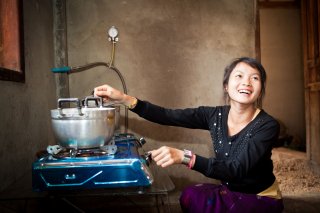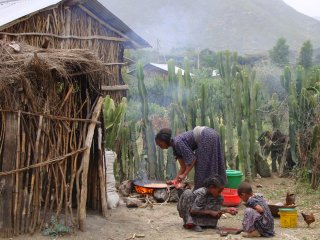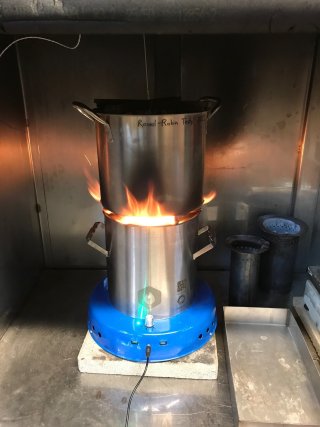Household Energy and Clean Air
Click YouTube icon to view video full sized.
EPA Administrator Michael Regan provided keynote remarks about the U.S. Government’s approach to advancing clean cooking and joined a panel about “Reducing Emissions from Cooking to Achieve Nationally Determined Contribution (NDC) Goals.
On this page:
- Introduction
- Health
- Climate
- Gender
- Research
- Partners and History
- Development and Promotion of ISO Standards
- Clean Cooking and Climate Consortium
Introduction
More than 40% of the world’s population—2.4 billion people—cook their food and light and heat their homes by burning coal and biomass fuels, including wood, charcoal, kerosene, dung, and crop residues, with open fires or rudimentary stoves. Burning solid fuels indoors for these household energy needs releases dangerous particulate matter, carbon monoxide, and other toxic pollutants, leading to indoor air pollution levels that are often 20 times greater than the World Health Organization’s (WHO) air quality guidelines. It also affects ambient air pollution by releasing greenhouse gases and black carbon into the air. This air pollution causes increased environmental health risk disproportionately impacting women and girls, contributes to climate change and the degradation of local environments, and exacerbates poverty in low-income communities. WHO estimates that emissions from these practices expose people to extraordinarily high levels of indoor air pollution, causing approximately 3.2 million premature deaths worldwide annually

To address this significant and multi-faceted challenge, EPA works with other U.S. government agencies and partner organizations to increase the sustained use of cleaner home cooking and heating practices that are affordable, reliable, efficient, and safer. These efforts aim to reduce household energy emissions resulting in improvements to human health both directly though cleaner indoor air and through improvements in gender equality, greater economic opportunity, and quality of life. These practices also result in fewer emissions of CO2 and other pollutants to reduce the climate and environmental impact of cooking and heating.
Health
Exposure to household air pollution from burning fuels like wood, charcoal, coal and kerosene is a leading risk factor for diseases including childhood pneumonia, chronic obstructive pulmonary disorder (COPD), acute respiratory infections, heart disease, stroke, and lung cancer. There is emerging evidence that when pregnant women are exposed to these pollutants, their infants are at increased risk for stillbirth, low birth weight, and decreased lung function.

Improvements in health outcomes can be made by replacing the polluting open fires and inefficient biomass stoves with improved biomass stoves that have been tested for efficacy. In the long term, increasing the use of cleaner, more modern stoves and fuels reduces harmful emissions and personal exposure to household air pollutants.
Around 20% of ambient air pollution globally, and often more than 50% locally (depending on the geographic area and the season), comes from cookstoves and household energy use. These emissions therefore can impact everyone in low-to-middle income countries.
Climate
In addition to significant health improvements, climate equity is another powerful factor behind improving household cooking and heating practices. It is estimated that greenhouse gas emissions from non-renewable fuels for cooking amount to a gigaton (one billion tons) of carbon dioxide per year. This represents about 2% percent of all global CO2 emissions; about the same amount of all global CO2 emissions from aviation or shipping. Each cookstove emits an estimated 2-6 tons of CO2 annually. Because improved stoves can reduce those emissions by 50-80%, many clean cookstove programs are eligible to receive carbon credits.
Household energy emissions are also the largest controllable source of the short-lived climate pollutant black carbon, and account for more than half of global black carbon emissions from human activities. Black carbon is a major component of fine particulate matter and has a per-unit warming capacity hundreds to thousands of times greater than carbon dioxide, making it one of the largest contributors to climate change. It is especially important to reduce black carbon emissions in mountainous regions like the Andes and Himalayas because the dark deposits on what would otherwise be reflective white surfaces of snow absorb the rays from the sun, which accelerates glacial melting, contributing to sea level rise and more extreme weather events like typhoons. This can also impact rainfall and the local climate.
The collection of wood for cooking and heating further contributes to climate change through forest degradation and land use changes, including the loss of wildlife habitat. Up to 34% of wood fuel is harvested unsustainably, and over 275 million people live in wood fuel “hotspots” where over 50% of wood fuel harvesting is unsustainable. Many of the people living in these areas already face other environmental and social factors that put them at higher risk of the impacts of climate change.
Gender

As the household members most often responsible for cooking and fuel collection, women and girls are disproportionately impacted by pollution due to solid fuel burning for household energy needs. The time women and girls spend collecting fuel affects their ability to attend school and pursue economic activities. Introducing more efficient and cleaner stoves reduces time spent collecting fuel and cooking and enables women to spend more time with their children, tend to other responsibilities, pursue income-generating or educational opportunities, and enjoy leisure activities and rest—all of which contributes to poverty alleviation.
Research
Research on emissions from cookstoves is conducted at EPA's household energy research and test facility in Research Triangle Park, North Carolina. The facility has state-of-the-art measurement capabilities to study emissions of gases and aerosols, including toxic air pollutants, greenhouse gases, and black carbon. Studies are conducted on multiple stoves and fuels under varying conditions to simulate operating conditions found in the field. EPA also provides funding and supports the field testing of cookstoves and fuels and conducts studies to understand the health effects from exposure to cookstove emissions.

EPA research supports (1) the development and implementation of international standards for testing cookstoves, (2) capacity building for international testing and knowledge centers, and (3) improved scientific understanding of air pollutant emissions and fuel efficiency.
In 2012, EPA awarded six Science to Achieve Results (STAR) grants to research air quality and climate impacts of burning solid fuels for cooking, lighting, and heating homes. This research contributed to understanding how effective cleaner burning methods can be to protect air quality and slow climate change. The STAR grants resulted in several scientific publications, and grantees have presented their results and latest research activities as part of Colorado State University’s Advancing Sustainable Household Energy Solutions (ASHES) program.
Partners and History
In 2002, at the World Summit on Sustainable Development, EPA and its partners launched the international Partnership for Clean Indoor Air (PCIA) which grew to more than 590 partners working in 135 countries to rapidly increase the sustained use of affordable, reliable, clean, efficient, and safe home cooking and heating technology and fuels.
- For more information on the PCIA, please see the PCIA legacy website.
In 2010, EPA Administrator Lisa Jackson joined Secretary of State Hillary Rodham Clinton, other US Government Agencies, and household energy leaders to announce the launch of the Global Alliance for Clean Cookstoves a public-private partnership led by the United Nations Foundation that focuses on creating a thriving global market for clean and efficient household energy solutions. The Global Alliance for Clean Cookstoves (the Alliance) was built upon the extensive network of organizations that comprised the Partnership for Clean Indoor Air. In 2012, the PCIA and the Alliance formally integrated. EPA continues to closely coordinate its household energy activities and initiatives with the Alliance in support of its mission.
The Alliance’s target of '100 by 20,' which called for 100 million homes to adopt clean and efficient stoves and fuels by 2020, was exceeded. The new goal for the household energy community is “universal access,” consistent with the United Nation’s Sustainable Development Goal #7: “Ensure access to affordable, reliable, sustainable and modern energy for all." In 2019, The Global Alliance for Clean Cookstoves changed its name to the Clean Cooking Alliance.
- Clean Cooking Alliance Website
- WHO Household Air Pollution
- For more information on what our federal partners are doing on household energy, visit their websites:
Colorado State University is an EPA partner and leading research lab on household energy. Their program, Advancing Sustainable Household Energy Solutions (ASHES), provides resources and learning opportunities. See a schedule of upcoming events and archived webinars on their website.
Development and Promotion of ISO Standards
A central component of EPA and partners’ international efforts to promote the adoption of clean cookstoves is helping to develop and implement International Organization for Standardization (ISO) standards for evaluating cookstoves. ISO is an international body that develops and publishes standards through international collaborative processes. The first breakthrough step in the standards development process was the publication of an ISO International Workshop Agreement (IWA), which was unanimously affirmed by more than 90 stakeholders present at the ISO International Workshop on Cookstoves February 28 – 29, 2012 in The Hague, Netherlands. The IWA provided guidance for rating cookstoves on four key performance indicators: fuel use/efficiency, total emissions, indoor emissions, and safety.
In 2013, ISO Technical Committee 285 (TC285) “Clean Cookstoves and Clean Cooking Solutions,” was launched at a Plenary Meeting hosted by the Kenyan Bureau of Standards in Nairobi, Kenya, and Working Groups focused on specific standard development activities were formed. In the ensuing years, TC285 experts have developed and published four ISO standards: Harmonized Laboratory Test Protocols — a standard test sequence for emissions and performance, safety and durability; Voluntary Performance Targets for cookstoves based on laboratory testing; Field Testing methods for cookstoves; and a Terms and Definitions document. Additionally, two new standards are under development: Test protocols for Institutional Cookstoves and Guidelines for Social Impact Assessment.
The Voluntary Performance Targets that were developed through this process can be adopted or adapted by any country through national policies. They allow countries to identify minimum performance levels for technologies for their specific national context. Standardized testing protocols facilitate international technology sharing and trade by building trust between laboratories.
Since the publication of these standards, EPA has been working closely with ISO, CCA, WHO, the Pan American Health Organization (PAHO) and other partner organizations to host Regional Standards Implementation Workshops. These events aim to support the adoption or adaptation, and then implementation of the ISO standards by working with policy makers, testing labs, non-governmental organizations (NGOs), and other stakeholders in the participating countries. A total of four workshops have been held with stakeholders in Asia, East Africa, Francophone Africa/Haiti, and Latin America, reaching a total of 44 participating countries. As part of every regional workshop, each participating country delegation developed an action plan for the promotion of the ISO standards and clean cooking in their country. EPA and partners continue to work with these delegations in support of their action plans.
Clean Cooking and Climate Consortium
Starting in 2021, EPA helped create the Clean Cooking and Climate Consortium (4C), a partnership led by the Clean Cooking Alliance (CCA) that also includes the United Nations Framework Convention on Climate Change (UNFCCC), the Climate and Clean Air Coalition (CCAC), Berkeley Air Monitoring Group, and Stockholm Environment Institute. This coalition aims to encourage country governments to include cooking energy goals in their Nationally Determined Contributions (NDCs) to the Paris Agreement, and to provide those countries with evidence and guidance on how best to articulate, plan, and meet those goals. As of the 2021 COP 26 meeting in Glasgow, 67 countries have included household energy or clean cooking goals in their NDCs.
Starting in March 2022, 4C began hosting a series of webinars for stakeholders in these countries to learn more about accessing opportunities for implementation support and potential funding, considerations for program design and implementation, and measurement, reporting, and verification (MRV) for clean cooking initiatives. The Consortium has developed the following guidance documents for interested countries, and continues to offer technical support.
